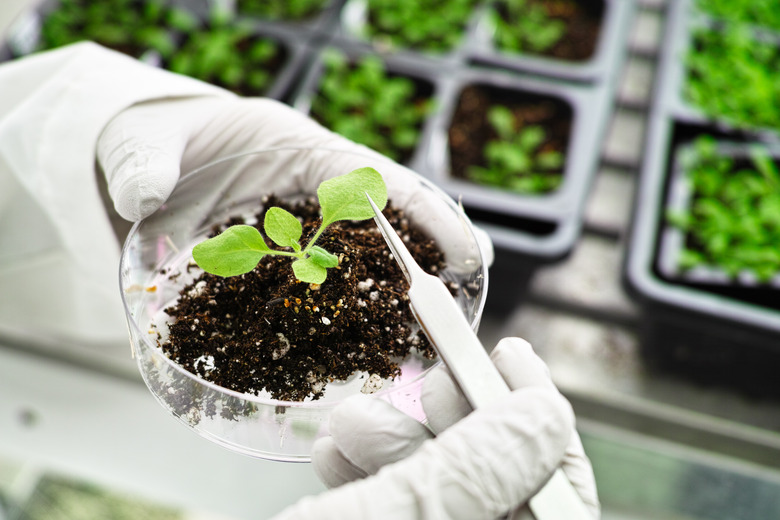Lab Experiments To Test For The Presence Of Starch When Using Potassium Iodine
Potassium iodide and iodine solutions are prime examples of indicators, chemicals used to identify the presence of various substances. Indicators change color when they react to a material — in iodine and potassium iodide's case, they react in the presence of starch. Because starch is incredibly common, these experiments with iodide solutions offer an interesting and easy way to learn about the use of indicators at home or in the classroom. Be careful using iodide solutions and do not eat food tested with it: the solutions can stain clothes and skin, and iodine can be poisonous.
TL;DR (Too Long; Didn't Read)
With a solution of potassium iodide, it's possible to test for the presence of starches in liquids, in foods and in freshly-trimmed plant leaves — where starches are naturally produced. Keep in mind that iodide solutions are only a _qualitative_ indicator for starches and not a quantitative one: they can detect that starches are present, but cannot determine how _much_ starch is present in a given substance.
Testing for Starches
Testing
for Starches
Plants form starches, polymer chains of individual glucose sugar molecules, to store extra energy produced during photosynthesis. Starches come in two forms that both curve into spiral shapes: one long polymer chain known as amylose, or many individual chains attached in branching patterns called amylopectin. Solutions of potassium iodide and iodine form complex iodide ions that, while soluble in water, change color in the presence of starches — the ions get stuck in the spirals of the starch polymer chains, forcing the iodide ions to become linear and change their electron arrangement. This causes a color change: in the presence of amylose, it becomes blue-black; With amylopectin it becomes a pale purple-red.
Testing in Solids
Testing
in Solids
Before you complete any test for starch, make an iodide solution first. Dissolve 10 grams (0.35 ounces) of potassium iodide and 5 grams (0.18 ounces) of iodine in 100 milliliters (3.4 fluid ounces) of water, then stir. You can use this solution to determine what foods or natural substances contain starches — place a few drops of the mixture on items such as chicken, potatoes, stones, cucumbers, wood, apples or pears, and watch to see if the solution changes color. If it does, the item contains starch.
Testing in Liquids
Testing in Liquids
Because the complex iodide ions in the solution are soluble in water, use them to test for the presence of starches in liquids as well as in solid items. For this experiment, fill four cups with liquids: two with plain water and two with milk. Dissolve a spoonful of corn starch in one of the water cups and one of the milk cups, then add a few drops of iodide solution to each — regardless of liquid, the solution will react to the corn starch if it's present.
Testing for Photosynthesis
Testing for Photosynthesis
You can use an iodide solution to test leaves for starch, and determine whether the plant has performed photosynthesis recently. To do this, put one green-leafed plant in a dark closet, and another on the windowsill where it can receive sunlight. Wait a few days, then take a leaf from each of the two plants: Blanch them in hot water and submerge each leaf in ethyl alcohol until the leaves are colorless. Once the leaves are taken out of the alcohol and placed on dishes, you can use the indicator solution to determine which of the leaves came from the windowsill plant, as only it will turn blue-black.
Cite This Article
MLA
Flournoy, Blake. "Lab Experiments To Test For The Presence Of Starch When Using Potassium Iodine" sciencing.com, https://www.sciencing.com/lab-experiments-test-presence-starch-using-potassium-iodine-12578/. 23 April 2018.
APA
Flournoy, Blake. (2018, April 23). Lab Experiments To Test For The Presence Of Starch When Using Potassium Iodine. sciencing.com. Retrieved from https://www.sciencing.com/lab-experiments-test-presence-starch-using-potassium-iodine-12578/
Chicago
Flournoy, Blake. Lab Experiments To Test For The Presence Of Starch When Using Potassium Iodine last modified March 24, 2022. https://www.sciencing.com/lab-experiments-test-presence-starch-using-potassium-iodine-12578/
